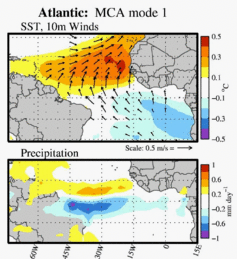Monthly Climate Timeseries:
Atlantic Meridional Mode (AMM) SST Index
- Description:
- The mode describes the meridional variabilty in the tropical Atlantic Ocean. A similar mode but for the Pacific is available.
- Image:
- Timeseries Plot:
- Select this link to get a plot. Plot is taken from the Timeseries Plotting and Analysis webpage.
- Calculation Method:
- The AMM spatial pattern is defined via applying Maximum Covariance Analysis (MCA) to sea surface temperature (SST; left field) and the zonal and meridional components of the 10m wind field (right field) over the time period 1950-2005, from the NCEP/NCAR Reanalysis. To define the spatial pattern, data are defined over the region (21S-32N, 74W-15E), and spatially smoothed (three longitude by two latitude points). The seasonal cycle is removed, data are detrended, a three-month running mean is applied to the data, and the linear fit to the Cold Tongue Index (a measure of ENSO variability) is subtracted from each spatial point. Spatial patterns are defined as the first left (SST) and right (winds) maps resulting from singular value decomposition of the covariance matrix between the two fields. The AMM time series below is calculated via projecting SST or the 10m wind field (detrended, CTI removed, but no 3-month running mean) onto the spatial structure resulting from the MCA above.
- Time Interval: Monthly
- Time Coverage: 1948 to present
- Update Status: Monthly
- Get Data:
- Update Status: Monthly
-
AMM (SST): Standard PSL Format (What is standard format?)
AMM (Wind): Standard PSL Format (What is standard format?)
- Source:
- Data is from U Wisconsin using the NCEP SST. Dats is obtained from his meridional modes data webpage.
- References:
-
- 2007 Kossin, J. P. and D. J. Vimont: "A more general framework for understanding Atlantic hurricane variability and trends". Bull. Amer. Meteor. Soc., accepted 5/24/2007.
- 2007 Vimont, D. J., and J. P. Kossin: "The Atlantic Meridional Mode and hurricane activity", Geophys. Res. Lett., 34, L07709, doi:10.1029/2007GL029683
- 2004 Chiang, J. C. H., and D. J. Vimont: Analagous meridional modes of atmosphere-ocean variability in the tropical Pacific and tropical Atlantic. J. Climate,17(21), 4143-4158.
